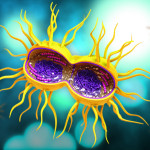Researchers in Atlanta report that cases of methicillin-resistant Staphylococcus aureus (MRSA), an aggressive and difficult-to-treat bacterial infection, have dropped considerably since 2007. These data, published March 17 in the journal AIDS, could signal the beginnings of a reversal of a trend of sharp increases in the infection during the past decade, particularly among HIV-positive men who have sex with men (MSM).
MRSA outbreaks generally occur in one of two venues: Health care institutions, such as hospitals, or in the general community. Since the mid-1990s, cases of both health care–associated and community-acquired MRSA have been increasing, and some of the circulating strains have become more virulent and more resistant to antibiotics than their predecessors.
Scientists and health care providers have expressed alarm at the increase in diagnoses of MRSA in people with HIV during the past 10 years, a rise that coincides with—but greatly surpasses—increases in the general population. Their alarm has not only been about the increased spread of the infection, but also about the growing difficulty of treating it among HIV-positive people and about the frequency in which it returns after being treated.
A previous study of nine metropolitan areas in the United States found a drop in cases of health care–associated MRSA in the general population. Intrigued by those findings, Alicia Hidron, MD, and her colleagues from Emory University School of Medicine in Atlanta, set out to assess trends in MRSA diagnoses within HIV-positive participants in an Atlanta Veterans Affairs (VA) medical system cohort.
Of the greater than 3,000 people enrolled in the VA cohort, Hidron’s team gathered data on 226 MRSA community-acquired infections that occurred in 168 HIV-positive people between 2002 and 2009. The majority of the cases, 94 percent, were community-acquired. Among those diagnosed with MRSA—nearly all of whom were black men—the average CD4 count at the time of their MRSA infection was 350. Fifty of the cases occurred in people with CD4s under 50, and 46 cases occurred in people with CD4s over 50 but under 200. Just over half of the cases were among men who have sex with men (MSM), and 14 percent were in injection drug users (IDUs).
MRSA infections were more than twice as likely to occur in MSM and IDUs as in people with other HIV risk factors. People with CD4s under 50 were more than four times as likely to develop MRSA, and those with CD4s between 51 and 200 were about twice as likely to develop the infection. Conversely, people taking antiretroviral (ARV) therapy were nearly three times less likely to develop MRSA.
Hidron’s team found that MRSA cases rose dramatically—more than 17-fold—between 2002 and 2007 but then began falling just as quickly between 2007 and 2009—when cases dropped by about 65 percent.
Though the study could not isolate the causes of the drop in MRSA infections, the authors theorize that several explanations are possible. First, they acknowledge that previous studies have found that changes in sex and drug-using behaviors and networks are often the primary driver of community-acquired MRSA, and that could be a factor here.
They also acknowledge, however, the significant difference in the risk of MRSA in people taking ARVs, compared with those not on treatment, and in people with higher versus lower CD4s. “To our knowledge, this study is the first to suggest that [ARV therapy] may result in a reduced risk of MRSA infections,” they state.
A third explanation may be that if hospital-acquired infections are dropping—as documented in the other study—there may also be a lower overall spread of MRSA in the general population, leading to fewer cases in people with HIV.
The authors are encouraged by the steep drop in MRSA cases among their cohort, but they are calling for further studies to help understand why this occurred.
Advertisement
Advertisement
Advertisement




Comments
Comments